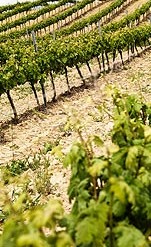1. Crianza – This is a fresh, youthful red wine that is aged in oak for a minimum of one year and then spends another year aging in the bottle.
2. Reserva – The Reserva ups the ante a bit from the Crianza both in complexity and in price. Again, Spain’s beloved Tempranillo is the dominant red grape and makes its presence known with commanding cherry flavors. The aging requirements for a Reserva is a minimum of one year in the barrel and another two years aging in either the barrel or bottle.
3. Gran Reserva – The creme de la creme of Spain’s Rioja red wines is the appropriately named Gran Reserva. These wines require barrel aging for two years and must have another three years (minimum) of bottle aging before they are released, making them a terrific wine find as they have already enjoyed 5 years of aging. The Gran Reserva is not made every year, but enjoys its high status because it is only made in extraordinary vintages.
Ribera del Duero Spanish Wine Region
This is another major red wine producing region of Spain that continues to gain recognition for its vibrant red wines, made predominately from the Tempranillo grape. The region is situated north of Madrid, but south of Rioja, smack in the middle of northern Spain. With a climate that is marked by intensity and extremes, the grapes have typically had to fight against a myriad of climate conditions to bear a bold bottle of red wine. As a result these reds typically exemplify both intensity and strength
Penedes Spanish Wine Region
The Penedes wine region is close in proximity to Barcelona on the Mediterranean coastline. This unique region is known for its sparkling wines which are called Cava, this sparkling wine is a great alternative to a champagne from France or Prosecco from Italy.
Rias Baixas Spanish Wine Region (pronounced Ree-ahss By-shass)
This region resides in Spain’s northwestern Galician region. Rias Baixas has become well-known and loved for its rich source of Albarino grapes which translate into very engaging and refreshing white wines. These dry, medium-bodied white wines are beloved for both their acidity and their tropical fruit-forward flavors. The U.S. is currently the leading importer of Spain’s Rias Baixas Albarino wines.
La Mancha region
Covers about half of the Castile-La Mancha region, stretching from just east of Toledo south to Puertollano and east to La Roda. The region is fairly flat and has a continental climate. This means that wine growers must contend with extreme temperatures as well as frequent droughts. La Mancha doesn’t get much rain because mountains encircle the region. Winters are cold, with temperatures as low as 10F, and summers are blazing hot, with highs in the low 100s. La Mancha produces red, rosé and white wines, with whites predominating. Airén is planted in approximately 80% of La Mancha’s vineyard acreage. Macabeo, the next most popular white wine grape, trails far behind at about 1% of planted acreage. Red wine grapes include cencibel (also known as tempranillo) 12%, and garnacha 3%.
Priorat wine region
This Spanish wine growing region is in the rugged mountainous zones of northeastern Spain, close to Penedes. The wineries producing in this region receive recognition for producing robust reds largely from Garnacha, Carignan, Tempranillo and Cabernet Sauvignon grapes that are high in alcohol and tout fairly macho tannin levels. That said, they are among the most expensive wines from Spain and are fairly hot newcomers on the international wine scene.
A note about Sherry
Sherry is a fortified wine made from white grapes that are grown near the town of Jerez, Spain. The word “sherry” is an anglicization of Jerez or Xéras, the French name for the town. In earlier times, sherry was known as sack from the Spanish saca, meaning “a removal from the solera”. “Sherry” is a protected designation of origin; therefore, all wine labeled as “sherry” must legally come from the Sherry Triangle, which is an area in the province of Cadiz between Jerez de la Frontera, Sanlecar de Barrameda, and El Puerto de Santa Maria.
After fermentation is complete, sherry is fortified with brandy. Because the fortification takes place after fermentation, most sherries are initially dry, with any sweetness being added later. In contrast, port wine for example is fortified halfway through its fermentation, which stops the process so that not all of the sugar is turned into alcohol.
Sherry is produced in a variety of styles, ranging from dry, light versions such as finos to much darker and sometimes sweeter versions.

